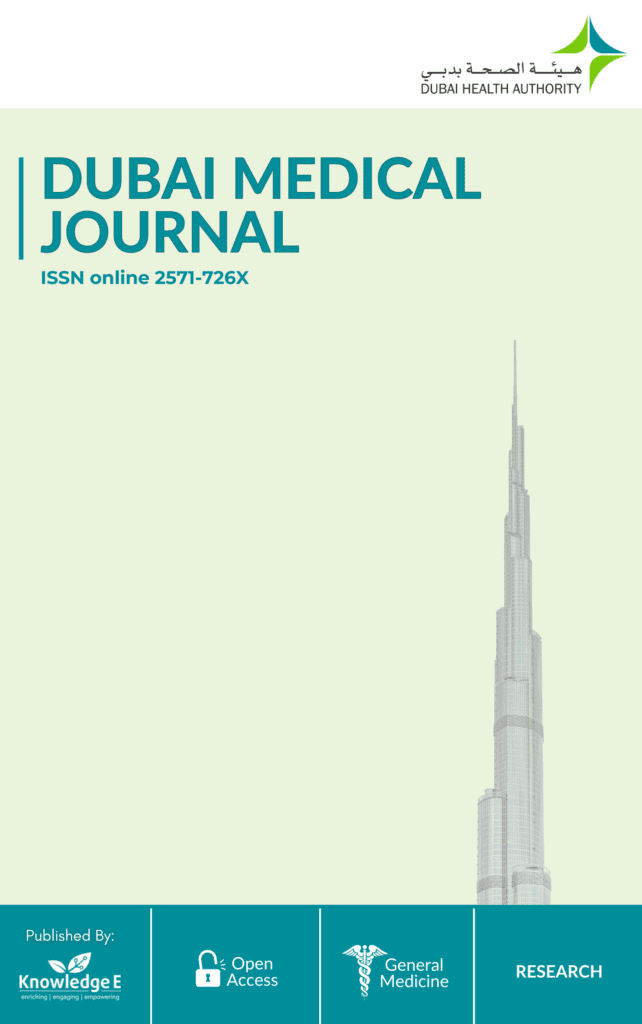
Dubai Medical Journal
ISSN: 2571-726X
Pioneering research in medicine, health sciences, nursing, pharmaceuticals, and laboratory work
Assessment of the Effect of Telephonic Follow-up on Readmissions and Mortality Rate of the Patients with Acute Coronary Syndrome and Acute Heart Failure in Rashid Hospital
Published date: Dec 08 2024
Journal Title: Dubai Medical Journal
Issue title: Dubai Medical Journal (DMJ): Volume 7, Issue 3
Pages: 137 - 148
Authors:
Abstract:
Background: Acute coronary syndrome (ACS) and acute heart failure (AHF) are severe medical conditions that are closely associated with higher rates of readmissions and mortality in hospitals. These conditions pose an exponential challenge to the healthcare system and increase patient burden.
Objectives: This study aims to identify the effect of telephonic follow-up on readmission and mortality rates in Rashid Hospital due to ACS and AHF.
Methods: In 2022, we conducted a prospective study. We divided 805 patients admitted with ACS and AHF in Rashid Hospital into two groups and compared the readmission and mortality rates of patients who were followed up with those who were not. The data collection tool included a demographic questionnaire, which was then analyzed by statistical tests and SPSS software.
Results: There were patients in the follow-up call group versus patients in the nonfollow- up call group. The patients with follow-up calls had a higher survival rate (98.3%) compared with the ones who had not been called (93.4%) (p = 0.003). Readmission rates for follow-up patients were (7.7%) versus (5.9%) for those without follow-up calls (p = 0.429). The study analyzed and investigated the individuals on various other factors; however, no statistically significant difference was observed between the two groups.
Conclusion: The study provides insight into the various factors associated with patients’ outcomes. Even though the association of readmission rate to follow-up was unremarkable, the mortality rate of patients with follow-up was significantly lower.
Keywords: acute coronary syndrome (ACS), acute heart failure (AHF), tele-follow up for re-admission, tele-follow up for mortality rate, follow up
References:
[1] Zegre-Hemsey JK, Asafu-Adjei J, Fernandez A, Brice J. Characteristics of prehospital electrocardiogram use in North Carolina using a novel linkage of emergency medical services and emergency department data. Prehosp Emerg Care. 2019;23(6):772–779.
[2] Siddiqi TJ, Khan Minhas AM, Greene SJ, Van Spall HG, Khan SS, Pandey A, et al. Trends in heart failure–related mortality among older adults in the United States from 1999-2019. JACC Heart Fail. 2022;10(11):851–859.
[3] Kurmani S, Squire I. Acute heart failure: Definition, classification and epidemiology. Curr Heart Fail Rep. 2017;14(5):385–392.
[4] Panagiotakos DB, Notara V, Georgousopoulou EN, Pitsavos C, Antonoulas A, Kogias Y, et al.; GREECS Study Investigators. A comparative analysis of predictors for 1-year recurrent acute coronary syndromes events, by age group: The Greek observational study of ACS (GREECS). Maturitas. 2015;80(2):205–211.
[5] Southern DA, Ngo J, Martin BJ, Galbraith PD, Knudtson ML, Ghali WA, et al. Characterizing types of readmissions after acute coronary syndrome hospitalization: Implications for quality reporting. J Am Heart Assoc. 2014;3(5):e001046.
[6] Oliveira LM, Costa IM, Silva DG, Silva JR, Barreto-Filho JA, Almeida-Santos MA, et al. Readmission of patients with acute coronary syndrome and determinants. Arq Bras Cardiol. 2019;113(1):42–49.
[7] Awoke MS, Baptiste DL, Davidson P, Roberts A, Dennison-Himmelfarb C. A quasi-experimental study examining a nurse-led education program to improve knowledge, self-care, and reduce readmission for individuals with heart failure. Contemp Nurse. 2019;55(1):15–26.
[8] Rich MW, Beckham V, Wittenberg C, Leven CL, Freedland KE, Carney RM. A multidisciplinary intervention to prevent the readmission of elderly patients with congestive heart failure. N Engl J Med. 1995;333(18):1190–1195.
[9] Harrison PL, Hara PA, Pope JE, Young MC, Rula EY. The impact of post discharge telephonic follow-up on hospital readmissions. Popul Health Manag. 2011;14(1):27–32.
[10] Reed GW, Rossi JE, Cannon CP. Acute myocardial infarction. Lancet. 2017;389(10065):197–210.
[11] WHO W. The top 10 causes of death. World Health Organization. 2018. https://www.who.int/newsroom/ fact-sheets/detail/the-top-10-causes-of-death
[12] Hernández Vargas JA, Trujillo-Cáceres SJ, Uriza-Pinzón JP, Franco OH. Maximizing the effects of physical activity on cardiovascular health: a matter of time? Eur J Prev Cardiol. 2023;30(3):230–231.
[13] Timar B, Braha A, Grigorică L, Gaiță L, Timar R. The impact of SGLT2i therapy on the onset and prognosis of heart failure in patients with type 2 diabetes. Timisoara Med. 2020(1).
[14] Mistiaen P, Poot E. Telephone follow-up, initiated by a hospital-based health professional, for postdischarge problems in patients discharged from hospital to home. Cochrane Libr. 2006;2006(4):CD004510. https://doi.org/10.1002/14651858.CD004510.pub3.
[15] Harrington D, Lenahan CM, Beacom R. Heart failure management: updated guidelines Understand your role in patient-centered care. Am Nurse Today. 2023;18(5):6–12.
[16] Narang N, Sayer G, Uriel N. Modalities 42 of left ventricular assist device optimization. Mechanical Circulatory Support: Principles and Applications, 2019;345.
[17] Zubaid M, Rashed WA, Al-Khaja N, Almahmeed W, Al-Lawati J, Sulaiman K, et al. Clinical presentation and outcomes of acute coronary syndromes in the Gulf Registry of acute coronary events (Gulf RACE). Saudi Med J. 2008;29(2):251–255.